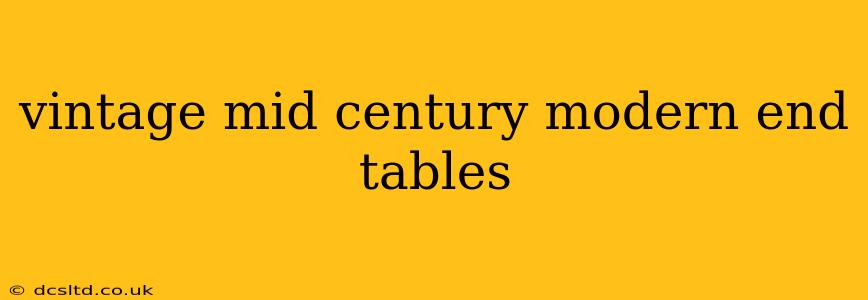The allure of vintage mid-century modern (MCM) furniture is undeniable. Its clean lines, organic forms, and functional design continue to captivate homeowners seeking unique and stylish pieces. Among the most sought-after items are vintage MCM end tables, offering both practicality and aesthetic appeal. This guide explores the world of these iconic pieces, helping you navigate the market and find the perfect addition to your home.
What Defines a Mid-Century Modern End Table?
Before diving into specifics, let's establish what characterizes a true MCM end table. These pieces typically embody the design principles of the mid-20th century (roughly 1933-1965), characterized by:
- Simple, clean lines: Avoidance of excessive ornamentation or fussy details.
- Organic shapes: Often incorporating natural forms and curves, a departure from purely geometric styles.
- Functional design: Emphasis on practicality and usability. Form follows function.
- High-quality materials: Use of durable materials like solid wood (teak, walnut, rosewood), metal (often brass or chrome), and laminate.
- Tapered legs: A common feature, often contributing to the overall sleek aesthetic.
What Materials Were Commonly Used in MCM End Tables?
Mid-century modern designers were masters of material selection, prioritizing both aesthetics and durability. Some of the most common materials you'll encounter in vintage MCM end tables include:
- Teak: Known for its rich, warm tones and durability.
- Walnut: A classic choice offering a dark, sophisticated look.
- Rosewood: Prized for its reddish-brown hues and striking grain patterns.
- Birch: A lighter-colored wood, often used for a more minimalist aesthetic.
- Laminate: A cost-effective and versatile material, often used in combination with other materials. While some consider laminate less desirable, it can contribute to a piece's unique charm and historical context.
- Metal: Brass, chrome, and steel were commonly incorporated into the legs, frames, or accents of MCM end tables, adding a touch of industrial chic.
How Can I Identify Authentic Mid-Century Modern End Tables?
Identifying genuine MCM end tables requires a keen eye for detail and a familiarity with the design language of the era. Look for these key indicators:
- Maker's marks or labels: Authentic pieces often bear the maker's mark or a label identifying the manufacturer and sometimes even the designer.
- Construction quality: MCM pieces are generally well-constructed with quality materials and joinery techniques.
- Design elements: Look for the characteristic clean lines, organic shapes, and tapered legs.
- Condition: While some wear and tear is expected with vintage pieces, excessive damage or significant repairs should raise concerns.
Where Can I Find Vintage Mid-Century Modern End Tables?
The hunt for the perfect vintage MCM end table can be an exciting adventure! Here are some avenues to explore:
- Online marketplaces: Sites like eBay, Etsy, and Chairish offer a vast selection of vintage furniture.
- Antique shops and flea markets: These venues offer opportunities to discover unique finds and potentially negotiate prices.
- Thrift stores and consignment shops: You may stumble upon unexpected treasures at lower price points.
- Estate sales: Estate sales frequently feature vintage furniture, often at attractive prices.
What Should I Look for When Buying a Vintage MCM End Table?
Before purchasing, carefully inspect the piece for any damage, paying close attention to:
- Structural integrity: Ensure the table is stable and free from wobbles or loose joints.
- Wood condition: Check for scratches, dents, water damage, or insect infestation.
- Finish condition: Examine the finish for any chips, scratches, or areas that need repair.
- Hardware condition: Assess the condition of any metal legs, handles, or drawer pulls.
How Much Do Vintage Mid-Century Modern End Tables Cost?
The price of a vintage MCM end table varies widely depending on factors such as:
- Maker and designer: Renowned designers or manufacturers command higher prices.
- Material: Rare or high-quality materials typically increase value.
- Condition: Well-preserved pieces in excellent condition are more valuable than those showing significant wear.
- Rarity: Unique or less common designs often fetch higher prices.
How Can I Care for My Vintage MCM End Table?
Proper care ensures your vintage MCM end table will remain a cherished piece for years to come. Avoid placing hot items directly on the surface and use coasters to protect the finish. Dust regularly with a soft cloth and use appropriate wood cleaner or polish as needed.
By understanding the defining characteristics, sourcing options, and care requirements, you can confidently navigate the world of vintage MCM end tables and find the perfect piece to complement your home's aesthetic. The hunt itself is part of the charm, leading to a unique treasure that reflects the enduring appeal of mid-century modern design.
